Metal-organic frameworks-derived metal phosphides forelectrochemistry application
Xinru Tang,Nan Li,Huan Pang
School of Chemistry and Chemical Engineering,Institute for Innovative Materials and Energy,Yangzhou University,Yangzhou,225009,Jiangsu,China
Abstract Metal-organic frameworks (MOFs) with high porosity and variable structure have attracted extensive attention in the field of electrochemistry,but their poor conductivity and stability have limited their development.Materials derived from MOFs can maintain the structural diversity and porosity characteristics of MOFs while improving their electrical conductivity and stability.Metal phosphides play an important role in electrochemistry because they possess rich active sites,unique physicochemical properties,and a porous structure.Published results show that MOF-derived metal-phosphides materials have great promise in the field of electrochemistry due to their controllable structure,high specific surface area,high stability and excellent electrical conductivity.MOF-derived metal-phosphides with significant electrochemical properties can be obtained by simply,economical and scalable synthetic methods.This work reviews the application of MOF-derived metal phosphides in electrochemistry.Specifically,the synthesis methodology and morphological characterization of MOFs derived metal-phosphides and their application in electrochemistry are described.Based on recent scientific advances,we discuss the challenges and opportunities for future research on MOF-derived metal-phosphides materials.
Keywords: Metal-organic frameworks;Metal phosphides;Electrochemistry
1.Introduction
With the further depletion of energy and the aggravation of environmental pollution,efficient,clean,and sustainable resources are urgently needed [1,2].Wind and solar power are promising sources of sustainable energy,but they are intermittent and do not solve existing problems.To achieve the efficient use of solar and wind energy,electrochemical technologies related to renewable energy need to be developed[3,4].Electrochemical energy storage devices,including batteries and supercapacitors show great potential,but both have limitations[5-9].In addition,electrocatalysis is also the focus of many research teams [10,11].Because electrochemical performance is closely related to electrode materials,it is necessary to find suitable alternatives to improve electrochemical performance [12,13].
Metal-organic frameworks (MOFs) with a high porosity and special morphology are new hybrid organic-inorganic crystalline porous materials that comprise a central metal and an organic ligand formed by spontaneous assembly [14-33].These substances are characterized by a controllable,highly porous structure [34,35],high specific surface area [36],channel modification,and good thermal stability [37] and durability.MOFs play an important role in catalysis [38],sensing [39-41],supercapacitors [42-44],batteries,and other electrochemical applications.Due to the poor chemical/mechanical stability and electrical conductivity of MOFs,their applications in electrochemical field are limited [45,46].Materials derived from MOFs can maintain the structural diversity and porosity characteristics of MOFs while improving their electrical conductivity and stability [47-50].The addition of MOFs to some composite materials can enhance electrical conductivity and promote electrochemical performance [51-53].Transition metal phosphides are widely employed because of their rich active sites,unique physicochemical properties,and controllable composition.The porous structure makes transition metal phosphides have excellent capacity and catalytic performance [54-62].We have found that metal-phosphide composites derived from MOFs have beneficial properties for energy storage,which makes them excellent prospects for applications in the electrochemical field.
In recent years,the electrochemical study of MOF-derived metal-phosphide materials have attracted widespread attention.Due to the economical and reasonable synthesis method of MOF-derived metal phosphating,it has remarkable electrochemical properties.The applications of MOF-derived metal-phosphide in areas such as electrocatalysis,sensors[63,64],supercapacitors,and batteries has been reviewed.For example,Wang and co-workers [63] CoPx@NCNTs) was prepared on the nitrophenol (p-NP) electrochemical sensing polyhedron results show CoPx@NCNTs have unique pore structure,high conductivity,high electrochemical active surface area,excellent properties of interface and internal diffusion and CoPxnanoparticles used in molecular recognition.The preparation of the sensors in the p-NP detection showed excellent electrochemical performance.However,there is almost no literature review of MOF-derived metal-phosphide materials.Therefore,this review outlines the research progress in the application of MOF-derived metal phosphide materials in catalysis,batteries and supercapacitors to promote future research breakthroughs.In particular,MOF-derived metal phosphides have been widely used in catalysis.The distribution of MOF-derived metal phosphides materials in catalysis,batteries,and supercapacitors is shown in Fig.1.As can be seen from the figure,MOF-derived metal phosphides have become an important focus of research teams in recent years.
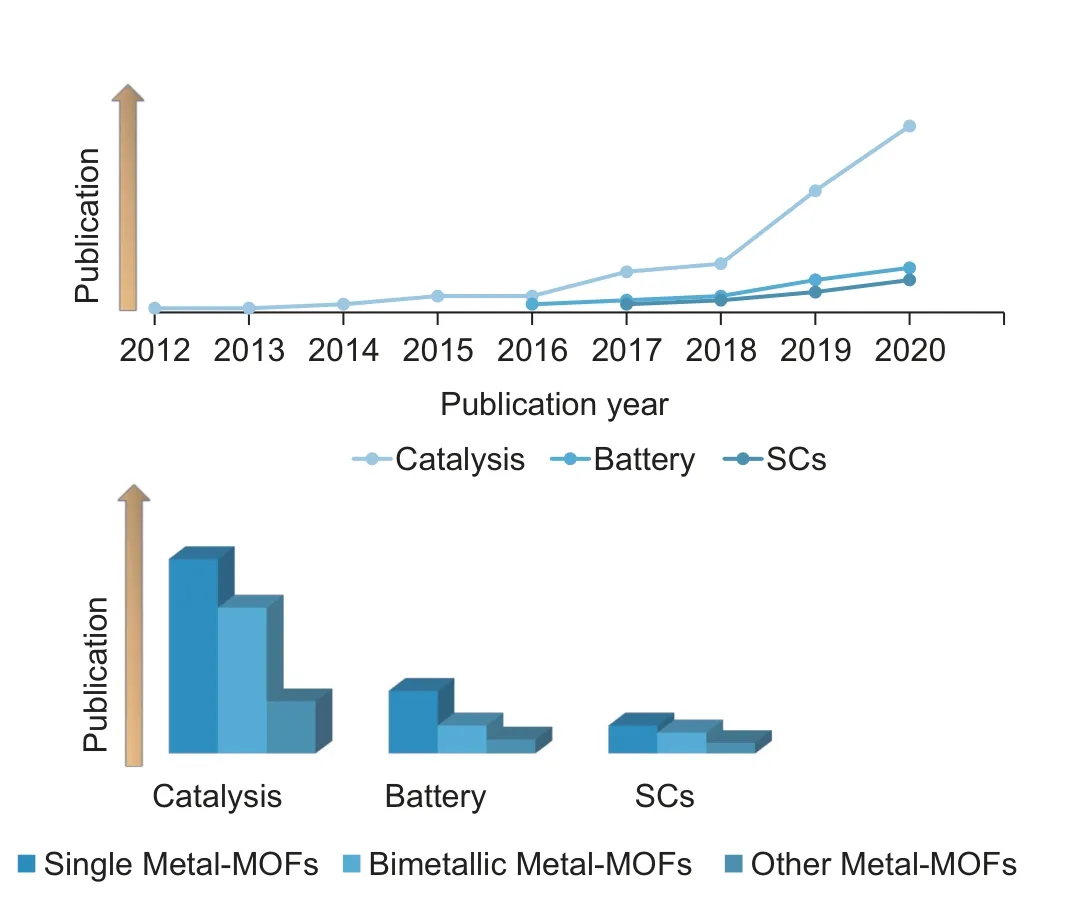
Fig.1.The distribution of MOFs derived metal phosphides materials in electrochemcatalysis,batteries,and supercapacitors.
2.Electrochemcatalysis
MOFs have well-organized channels,controllable pore size,flexible structure,and good reducing capability [65-73].Functional MOF has strong antioxidant capacity,and it was found that redox strategy can improve the electrical conductivity of MOFs,thus improving the electrochemical capacity[73].MOF-derived materials have abundant suspended bonds,which can harmonize the unsaturated property and improve the electrocatalytic activity.Metal phosphides have advantages of low cost,high activity,and good stability and are regarded as new highly efficient catalysts [74,75].Therefore,metal phosphides derived from MOF with these advantages may be good catalysts [76-84].In recent years,there has been considerable research on the catalysis of MOF-derived metal phosphides [85].For example,Jiao and co-workers [86]developed a cobalt-phosphide-reduced graphene oxide (CoP/rGO) layered composite by template growth,subsequent pyrolysis,and a phosphating process that acts as a bifunctional catalyst for complete water decomposition.The CoP/rGO-400 nanocomposite displays excellent hydrogen evolution reaction(HER) performance in several solvents.A MOF-derived composite can improve this catalytic activity to a certain extent [87-89].Composite materials with MOF-derived metal phosphides in reactions,this catalyst exhibits very high performance.In acidic and alkaline solutions,the current density is 10 mV cm-2when the low overpotential is 65.8 mV and 16.0 mV,which indicates that it has good stability and HER activity [90].Fig.2 depicts the utilization of MOFs derived metal phosphides in the field of electrochemistry.Table 1 and Table 2 show research results regarding the application of MOFs in the HER and oxygen evolution reaction (OER) in recent years.
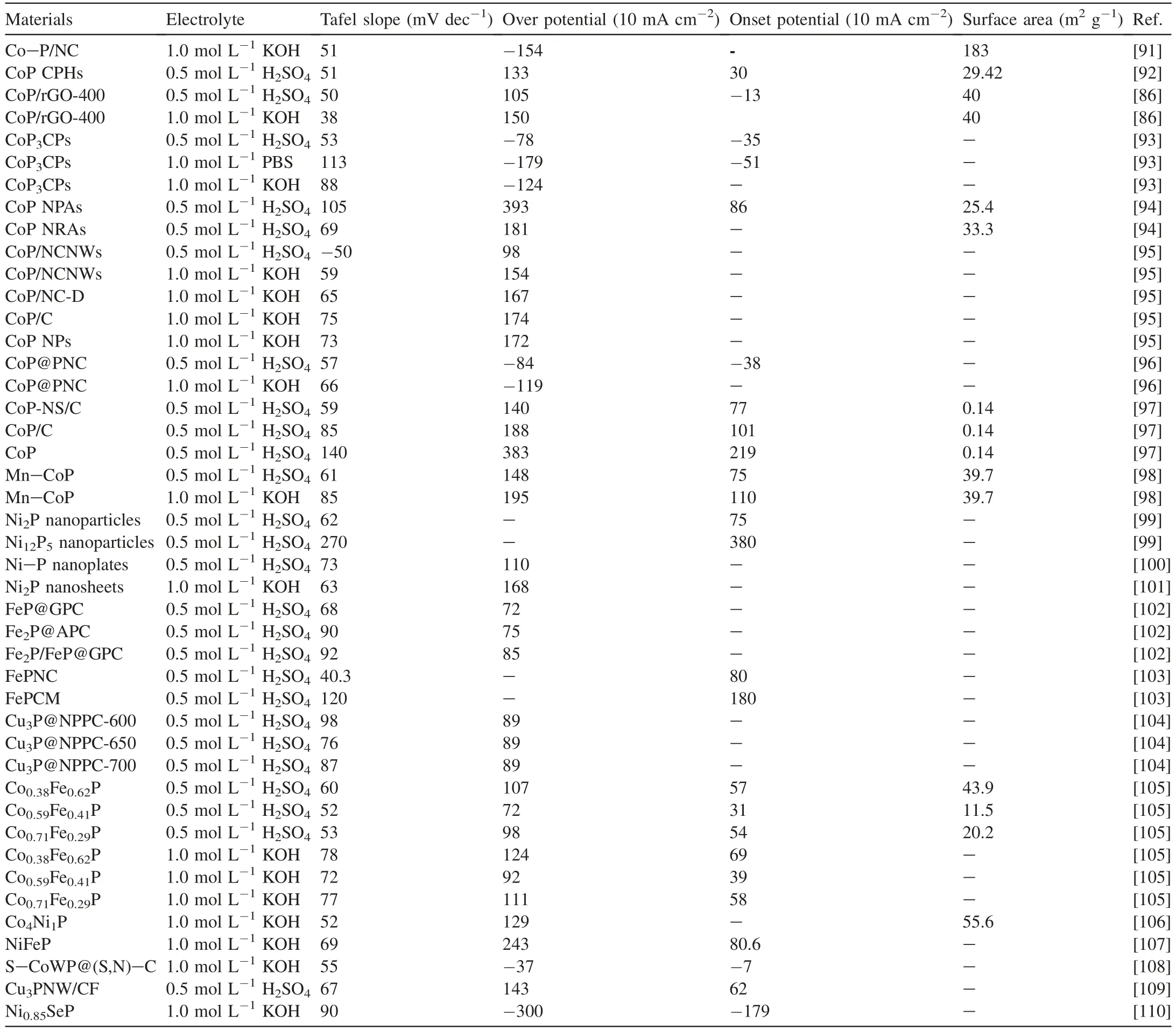
Table 1 MOFs derived metal phosphides materials of HER.

Table 2 MOFs derived single metal phosphides materials of OER.
2.1.MOF-derived single metal phosphide
2.1.1.Cobalt-phosphide composite
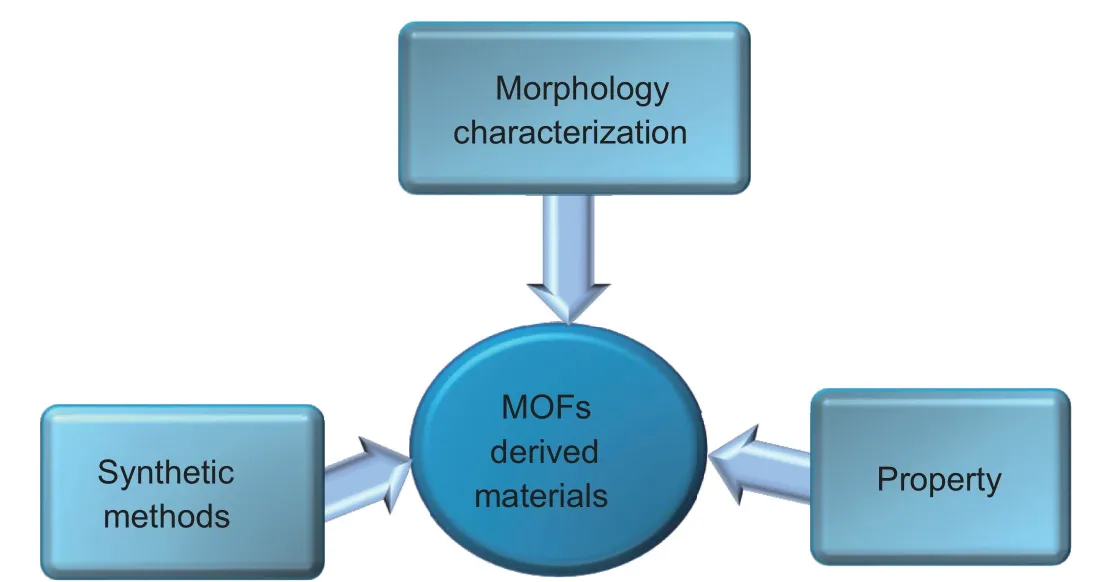
Fig.2.The description method of the MOFs derived metal phosphides in electrochemistry.
In recent years,the catalytic activity of MOF-derived metal-phosphide materials have attracted increasing interest.Early attempts to use MOF-derived cobalt-phosphide composites as catalysts were reported by You and co-workers[91]in 2015 using a simple MOF-derived route to prepare Co-P/NC nanoscale polyhedra.The results show that the material has excellent catalytic activity in HER and OER.Fig.3a shows a simple two-step synthesis of a porous CoP/NC nanopolyhedron by means of ZIF-67.The first step is carbonization,and the second step involves phosphorization to obtain Co-P/NC.The porous polyhedron was prepared by embedding an N-doped carbon matrix in the catalyst nanoparticles (a mixture of CoP and Co2P),producing a complete water decomposition catalyst.Fig.3d shows a schematic of the two-step synthesis of Co-P/NC.Jiao et al.[86]also prepared a CoP/rGO-layered composite by a GO-templated MOF growth and pyrolytic phosphating process.It is a bifunctional catalyst.The results show the CoP/rGO-400 nanocomposite to have excellent HER performance.Fig.3b shows the three-step synthesis of CoP/rGO-T composites.Fig.3g shows the polarization curve to be nearly consistent with the original trace in 0.5 mol L-1H2SO4after 3000 weeks of continuous cyclic voltammetry (CV) scanning.As shown in Fig.3h,CoP/rGO-400 obtained almost the same result under the alkaline condition of current density of 10 mA cm-2and overpotential of 150 mV.The performance of the catalyst is better than that of bare GCE and CoP/rGO.The difference is that Yang and coworkers [115] showed results for a new type of Co2P/CNxcomposite prepared from a ZIF-67 nanotube injected with red phosphorus.The results reveal the potential of cobalt-phosphide-based materials in traditional catalytic processes.Fig.3c illustrates the preparation of Co2P/CNx.Uniform ZIF-67 nanocubes are first prepared with the help of a cetyltrimethylammoniumbromide (CTAB) capping agent.The porous Co2P/CNxcomposite is then mixed with red phosphorus and calcined.Xu et al.[92] synthesized porous CoP CPHs by low-temperature multistep calcination.The material displays aconcave polyhedral structure,which improves the electrocatalytic activity in the HER.The morphology and structure of CoP CPHs are demonstrated in Fig.3e-f.Careful inspection of the SEM in Fig.3e shows the surface of the PHs to be concave and quite rough,which reflects their porosity.The SEM images of the prepared samples in Fig.3f display good dispersion and polyhedral (PH) nanostructures with an overall size of 100-250 nm.
Different from the above research team,Wu and coworkers [93] displayed the synthesis of MOF-derived porous CoP3concave polyhedrons (CoP3CPs) by toptactic phosphorization in a sealed quartz tube with ZIF-67.The products exhibit good stability and electrocatalysis in the HER and OER.Fig.4a shows the CoP3samples to be polyhedral nanostructures after carbonization and phosphorization,and the pore size of the sample is about 200 nm.The SEM image shows that the surface of CoP3CPs to be rough and uneven,indicative of a large surface area and high porosity in Fig.4b.Fig.4f shows that CoP3CPs has excellent HER and OER activity.Using ZIF-67-Co as the precursor,CoP NPAs and NRAs by direct synthesis under mild phosphating conditions(Fig.4c) have been prepared by Li and co-workers [94].The materials show high cathodic current densities at low overpotentials and good electrochemical properties such as electrocatalytic durability and significant HER activity.The materials are a low-cost alternative to precious metal Pt catalysts.As shown in Fig.4g,chronoamperometric response is maintained at 97.9%of the original catalytic current after 10 h operation,indicating good durability.At the same time,a stable overpotential is maintained under continuous operation at a constant cathode current density of~39.6 mA cm-2.The difference is that Yu et al.[95] synthesized the novel Cophosphide nanocrystals doped with N-doped carbon nanowires that used the N-Co-based MOF as the precursor.The material has a relatively complete structure,abundant catalytically active sites,and rapid charge transfer capability,which provide it with greater electrocatalytic activity than the irregular composite material without N-CoP/carbon.The cobalt ions and trivalent anions combine to form the planar structure shown in Fig.4d.Upon the addition of 4,4′-bipyridine (4,4-bpy),the two single crystals protrude vertically with in a 2Dframework to form multi-channel nanostructures.Shen and coworkers [116] first reported that Co2P nanoparticles derived from Co-MOFs are effective in increasing catalytic hydrogen production based on nanometer-scale g-C3N4tablets,which demonstrates the synergistic effectiveness of Co2P and K2HPO4.As shown in Fig.4e,schematic diagram of catalytic hydrogen mechanism in the ternary catalytic system of GC3N4-CO2P-K2HPO4.
Subsequently,Zhou and co-workers [96] reported CoP@PNC nanoparticles obtained by simple coupled phosphorization and carbonization of Co-MOFs (Fig.5a).CoP@PNC exhibit superior HER(-84 mV and-119 mV in acid and alkaline media,respectively) and OER (330 mV in alkaline media)performance,because the combination of P-N and Co-doped carbon maximizes conductivity and the electrochemically active surface area (ECSA).The material can be employed as an efficient and inexpensive dual-function electrocatalyst and can optimize electrocatalytic performance by maximizing conductivity.Fig.5f shows an evaluation of CoP@PNC durability at a current density of 10 mA-2.The overpotential is basically unchanged after 20 h.The difference is that Li and co-workers [98] used ZIF-67 as a precursor to carefully prepare Mn-CoP a new nanocomposite with a 2D structure by etching,carbonization,and phosphorization.Mn-CoP exhibits excellent bifunctional electrocatalytic behavior in acidic and alkaline solutions.The overpotential of OER is 148 mV and 195 mV at 10 mA cm-2,respectively,under acidic condition of 0.5 mol L-1H2SO4and alkaline condition of 1 mol L-1KOH.At the same time,the catalyst also showed excellent OER performance with an overpotential of 290 mV and a current density of 10 mA cm-2,which is equivalent to commercial RuO2.More importantly,this catalyst can maintain good stability for both HER and OER.The synthetic approach of Mn-CoP nanometer sheet formation comprises the three steps of etching,carbonization and phosphorization in the Fig.5b.In the first step,reflux is carried out in a mixed solution of ethanol and water containing a hard template of ZIF-67 particles and the Mn(NO3)2·4H2O etching agent.The second step involves observation that it is fully transformed into two-dimensional MnCo2O4nanometer tablets after 15 min.The final Mn-CoP 2D nanosheet is prepared by phosphating roasting after a 2 h heat treatment in N2at 600°C.Fig.5e shows SEM images of the phosphatized product.Li and co-workers [97] also reported the preparation of cobalt phosphide nanocomposites (CuP-NS/C) by a new MOF-template method.These materials exhibit excellent bifunctional electrocatalytic HER and OER activity.The result shows the preparation of Cu-NS/C nanorods via a MOF-based nanorod synthesis strategy in Fig.5c.ZIF-67 is transformed into ZIF-67 nm sheets (ZIF-NS) by solvent heat treatment,after which NaH2PO2is used as a phosphorus source to convert ZIF-NS into Co-NS/C by low-temperature phosphorization.The optimized Co-NS/C possesses high stability and excellent electrocatalytic activity in the HER and OER,in both acid and alkaline media,respectively.Fig.5d contains TEM and SEM images of CoP-NS/C,which demonstrate the nanosheet morphology of CoPn-NS/C.
MOF-derived Co-phosphide composites employed in the electrocatalysis are described in terms of synthesis method,morphology,performance,and application.We know from the literature that the synthesis of MOF-derived cobalt-based phosphides generally relies on the use of MOFs as starting materials with conversion to Co-based phosphide composites accomplished by phosphorization in a series of steps.MOFderived cobalt-based phosphide materials display a highly porous,3D interconnected mesoporous structure and high specific surface area,conductivity,recyclability,stability,and long-term durability.These properties are important contributors to their beneficial catalytic activity.Firstly,the highly porous structure promotes gas release and mass transfer during the reaction and the accessibility of active sites,which exposes more active centers and provides more electron transfer pathways to improve the electrocatalytic activity.Furthermore,the large specific surface area increases the number of reactive sites,which is conducive to electron and mass transfer in electrocatalytic processes and further enhances catalytic activity.Good conductivity facilitates better charge transfer and more rapid electron transfer in energizing the active sites.MOF-derived Co-phosphide composite materials have high recyclability,which is an important property of catalysts.Good stability and excellent durability are also indispensable features.MOF-derived Co-phosphide composites provide low loss and good catalyst stability under longterm operation.A final point is that the synergistic effect of MOF-derived cobalt phosphides with various composite materials increases catalytic activity by enhancing the performance characteristics of MOF-derived cobalt phosphides in the OER and HER.Because of their good catalytic performance in the field of electrochemistry,these materials promote faster and better reactions and solve the problem of low reaction efficiency.MOF-derived cobalt-based phosphide composites materials have promising applications in the field of electrochemistry and the ability to serve as efficient bifunctional catalysts.
2.1.2.Nickel-based phosphide
2.1.2.1.Nickel phosphide.Early attempts to use MOF-derived nickel-phosphide materials in catalysis have been reported by Tian and co-workers [99].They synthesized nickel phosphide nanoparticles by the conversion of the Ni-MOF (Ni-BTC MOF) precursor of p-benzene-1,3,5-tricarboxylic acid under mild conditions.The excellent HER-activity of MOF-derived Ni2P nanoparticles is attributed to the high cathode current density and onset overpotential of 75 mV.Compared with other metal phosphides,Ni2P nanoparticles are worth investigating as a low-cost substitute for precious platinum catalysts.The preparation method generally follows the synthesis of other transition metal phosphides(TMPs)by MOFs and has the prospect of widespread application.
2.1.2.2.Nickel-phosphide composite.As mentioned above,nickel phosphides possess promising applications in catalysis.Early attempts to use homogeneous NiPxnanospheres by electrosynthetic cyclic voltammetry deposition method have been prepared by Chen and co-workers [74],which was used as an efficient electrocatalyst for HER in neutral solution.The overpotential of the electrocatalyst for HER is 230 mV,the onset overpotential is about 135 mV,and the Tafel slope is 101 mV dec-1,indicating that it has excellent electrocatalytic performance.In addition,the electrosynthesis catalyst attaches directly to the reactants without any binder polymers,thus forming an integral electrode and increasing stability during the catalytic process.It has a wide application prospect for the development of practical,mild and efficient catalysts for water decomposition in the future work.In previous attempts,Yu and co-workers [100] synthesized MOF-derived nickel-phosphide composite materials.They developed a simple MOF synthetic strategy using a Ni-Ni Prussian blue analog (PBA)as a precursor to prepare porous Ni-P nanoplates as an OER electrocatalyst.Due to its ideal nanostructure and the in-situ generated OER activity of nickel oxide,the product showed enhanced OER electrocatalysis.The catalyst is overpotential at 300 mV to achieve a current density of 10 mA cm-2,which can be compared with other non-noble metal OER electrocatalysts.The Ni-P materials also exhibit good electrocatalytic HER activity in acidic solutions and long-term stability in alkaline and acidic media.In Fig.6a,the FESEM image shows the porosity of the Ni-P nanoplate.The synthesis strategy of porous Ni-P nanoplates is Ni(H2O)2[Ni(CN)4]-PBA(NiNi-PBA) nanometer plates first synthesized with a simple co-precipitation method and used as templates.The NiNi-PBA plates are calcined in air,and the nanoporous Ni-P plates are prepared by phosphating the Ni-P template in argon at low temperature (Fig.6c).
Additionally,Wang and co-workers [101] have fabricated additional Ni-P materials.Using NiO-MOF-74 as a precursor,porous Ni2P nanometer tablets (Fig.6d) were prepared by a simple phosphating treatment,and used as bifunctional electrocatalysts.Porous Ni2P nanosheets have a high specific surface area,good conductivity,and good electrochemical stability and exhibit excellent electrocatalytic performance for both the HER and OER in a 1.0 mol L-1KOH solution.The porous channels of the Ni2P nanosheet provide a pathway for electron conduction and thereby promote electron transfer and accelerate the diffusion of bubbles on the electrode surface.Fig.6f shows that the current loss is very small after 1000 CV cycles,indicating that the product has good electrocatalytic stability in the HER.As shown in Fig.6g,the porous Ni2P nanosheets have a low overpotential of 168 mV at 10 mA cm-2,which is less than that of the original Ni2P material.Thus,the porous structure connected by C=C units provides a large surface area and good electrical conductivity.The porous structure also enriches the number of active sites needed for reaction and accelerates electron transfer.

Fig.3.(a)Synthesis of porous Co-P/NC nano-polyhedron.(b)The preparation process of CoP/rGO-T nanocomposites.(c)Synthesis of Co2P/CNx nanotubes.(d)The synthesis of Co-P/NC nanopolyhedron.(e,f)SEM images of Low and high magnification.(g)Electrochemical HER activity of CoP/rGO-400.(h)Durability test in 0.5 mol L-1 H2SO4 solution and LSV curves.(a,d)Reprinted with permission from Ref.[91]Copyright 2015 American Chemical Society.(b,g,h)Reprinted with permission from Ref.[86]Copyright 2016,The Royal Society of Chemistry.(c)Reprinted with permission from Ref.[115]Copyright 2018,Wiley-VCH.(e,f)Reprinted with permission from Ref.[92] Copyright 2015,The Royal Society of Chemistry.
Different with Wang and co-workers,Kumar et al.[117]have synthesized inexpensive Ni2P nanoparticles by following a simple MOF strategy.Ni2P acts as a cooperative catalyst on the CdS surface and can be used to catalytic water splitting to produce H2.The hydrogen production rate with Ni2P is 6.2 times greater than that with pure CdS and 2.6 times greater than that with an expensive Pt/CdS co-catalyst,which attests to the high catalytic activity of Ni2P.The Ni2P/CdS catalyst performed reproducibly and was recovered after at least three cycles with little loss in activity.Fig.6b shows the progress of efficient H2production with Ni2P/CdS catalyst.The diagrammatic progress of Ni2P/CdS preparation is shown in Fig.6e.
MOFs derived nickel-based phosphides and their composite materials are described electrochemically by their synthetic method,morphology,and performance.The literature indicates that MOF-derived Ni-based phosphides and their composites are synthesized by a phosphating process comprising a series of steps involving nickel phosphides and composites.MOF-derived nickel-based phosphides and their composite materials have a porous structure characterized by a high surface area,low overpotential,and good conductivity,durability,stability,and charge transfer capability.These qualities lead to excellent electrocatalytic properties.The porous structure of MOF-derived nickel-based phosphides and composites promotes good catalytic activity,because it increases of the number of active sites,promotes the distribution of electrolytic reactants,increases the reaction rate,and provides electronic conduction channels,all of which enhance electron transfer.Good conductivity also accelerates electron transfer and further improves catalytic activity.Superior stability and durability are important properties of an efficient catalyst.Finally,the synergistic action of MOF-derived nickelbased phosphides and their composite materials greatly enhances the catalytic performance of OER and HER.
2.1.3.Iron-phosphide composite
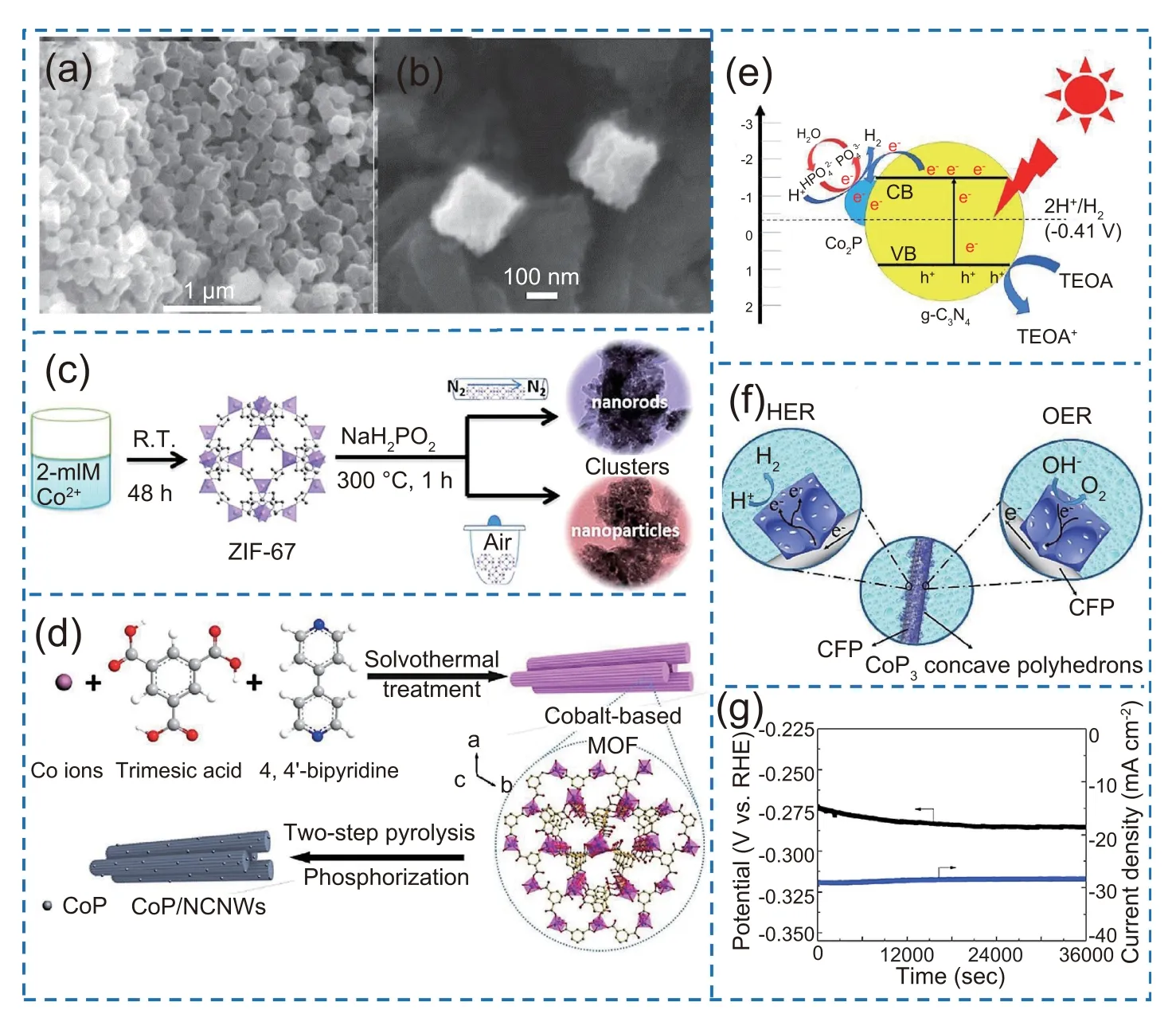
Fig.4.(a) Low power SEM images of CoP3CPs.(b) high power SEM images of CoP3CPs.(c) The formation process of CoP NPCs and CoP NRCs.(d) CoP/NCNWs integrated schematic diagram.(e)Schematic diagram of catalytic hydrogen mechanism in the ternary catalytic system of G-C3N4-CO2P-K2HPO4.(f)A schematic of CoP3 CPs HER and OER work.(g) The chronopotential durability test of CoP NRAs at a constant current density of 39.6 mA cm-2 and an overpotential of 250 mV,respectively.(a,b,f) Reprinted with permission from Ref.[93] Copyright 2017,The Royal Society of Chemistry.(c,g) Reprinted with permission from Ref.[94]Copyright 2015,The Royal Society of Chemistry.(d)Reprinted with permission from Ref.[95]Copyright 2019,Elsevier.(e)Reprinted with permission from Ref.[116] Copyright 2017,American Chemical Society.
Early attempts by Fang and co-workers [111] reported MOFs derived iron-phosphide composite materials in electrochemcatalysis.They prepared a flake-like Fe-Ni-P/rGO composite by templated growth,heat treatment,and phosphating to achieve highly efficient OER electrocatalysis(Fig.7a).By integrating highly porous properties with the synergies of iron and nickel to enhance conductivity,the Fe-Ni-P/rGo-400 composite exhibits OER performance and stability in alkaline solutions that surpass the most advanced IrO2and OER catalysts reported to date.Fig.7d illustrates the flake-like structure of 150 nm thick Fe-Ni-P/rGO-400.They provided a new strategy for the synthesis of porphyrin-type MOF-GO composite.Yao and co-workers [102] reported an effective method for preparing high performance,dispersed iron-phosphide nanoparticles.Using Fe-mil-88 as a precursor,they prepared a graphite carbon structure embedded with metal by high-temperature pyrolysis and phosphorization to obtain FeP@GPC.In acidic medium,the catalyst needed an overpotential of 72 mV in order to obtain for HER at 10 mA cm-2.In alkaline medium,278 mV overpotential is needed to obtain for OER at 10 mA cm-2.It is proved that FeP@GPC is one of the best electrocatalysts.Fig.7b shows the main process of FeP@GPC preparation.
High-porosity FePNC nanocomposites with highly ordered nanostructures have been synthesized by Lim et al.[103].FePNC has excellent electrochemical properties including high velocity energy and long cycle stability for use as electrocatalyst and sodium-ion battery (SIB) anode material.Fig.7c describes the synthesis of FePNC.After phosphorization,the material retains a good morphology,but the surface becomes uneven(Fig.7e),which indicates that the nanoparticles form a porous structure during carbonization/phosphorization.Fig.7f shows the rate capabilities of FePCM and FePNC.FePNC achieves rates of 410.6,314.8,239.4,179.6 and 122.8 mA h g-1at 100,200,500,800,and 1000 mA g-1,respectively.When the current density is returned to 100 mA g-1,the specific capacity is restored to 358.9 mA h g-1,which is indicative of high reversibility.The specific capacity of FePCM at the same current density equals 147.8,84.1,57.5,39.9 and 27.0 mA h g-1,respectively,indicating a lower specific capacity for this material.Fig.7g compares the long-term cyclic stability of FePCM and FePNC at 200 mA g-1,which shows FePNC to have better long-term stability.FePNC has a large specific surface area and a uniform hybridized nanostructure,which facilitate volume changes and efficient ion diffusion in electrochemical reactions and,thus,improve the yield capacity and long-term cycle stability.
The synthetic methods and performance applications of MOF-derived Fe-based phosphide composites have been described above.These materials have a highly porous structure,a large surface area,and good electrical conductivity,stability,durability,kinetic characteristics,and electrocatalytic activity,which makes them excellent resources in the field of electrocatalysis.Firstly,the highly porous structure improves the electrical conductivity of MOF-derived Fe-based phosphide materials and provides them with excellent storage performance,highly rate capacity,and long cycle life.These are prominent performance advantages.Furthermore,the rapid kinetics and good electrochemical properties provide MOFderived Fe-based phosphide composites with low overpotential,high exchange current density,small Tafel slope,good stability,and large exposed active sites,which further improve electrocatalytic activity.This enhancement of the distinct properties of MOF-derived Fe-based phosphide composites upon combination illustrates their concomitant effect.The above results describe the excellent performance of MOFderived Fe-based phosphide composites in the field of electrocatalysis and portend their broad electrocatalytic application.
2.1.4.Copper-phosphide composite
Early attempts to use MOF-derived copper phosphide composite materials in catalysis have been reported by Wang and co-workers [104].They reported the first design of a uniformly dispersed Cu3P NP coating on N,P co-doped carbon shells and the embedding of the same doping into a graded porous carbon matrix using a new Cu-based MOF containing double chains as a template.The catalyst has a large specific surface area,excellent HER and OER activity,and good durability.The catalyst can be used as an air-negative pole to carry out energy conversion in a zinc/air battery.The SEM images of Cu3P@NPPC in Fig.8a show the formation of a well-maintained fluffy mesh by phosphorization.Fig.8c shows the three steps in the synthesis of Cu3P@NPPC.In the first step,a Cu-NPMOF is synthesized by self-assembly with N-containing pyrazine ligands and inexpensive P-containing HEDP ligands and used as a single precursor for calcination.The Cu-NP MOF is pyrolyzed to Cu@NPPC under a N2atmosphere in the second step.Cu3P@NPPC is prepared in the third step by phosphorization of Cu@NPPC under a N2atmosphere.Peng et al.[118] also reported that Cu3P/C composites can be synthesized by a simple method with high selectivity,low starting potential,and inexpensive CO2RR catalyst potential.Cu3P/C achieves a high Faraday efficiency of 47% at a relatively low potential.Fig.8b shows SEM images of Cu3P/C and its flower-like microstructure.Copperphosphide composite materials have been reported by Tian and co-workers [109].They produced a self-supporting Cu3P nanowire array on porous CF via the low-temperature phosphorization of a Cu(OH)2NW/CF precursor.The results show that Cu3P NW/CF,as an integrated three-dimensional (3D)hydrogen evolution cathode,has excellent durability and electrocatalytic performance and durability in acidic aqueous solution.Specifically,the onset overpotential is 62 mV,Tafel slope is 67 mV dec-1,and Faraday efficiency is close to 100%.The current density of 10 mA cm-2can only be provided under the condition of 143 mV overpotential.
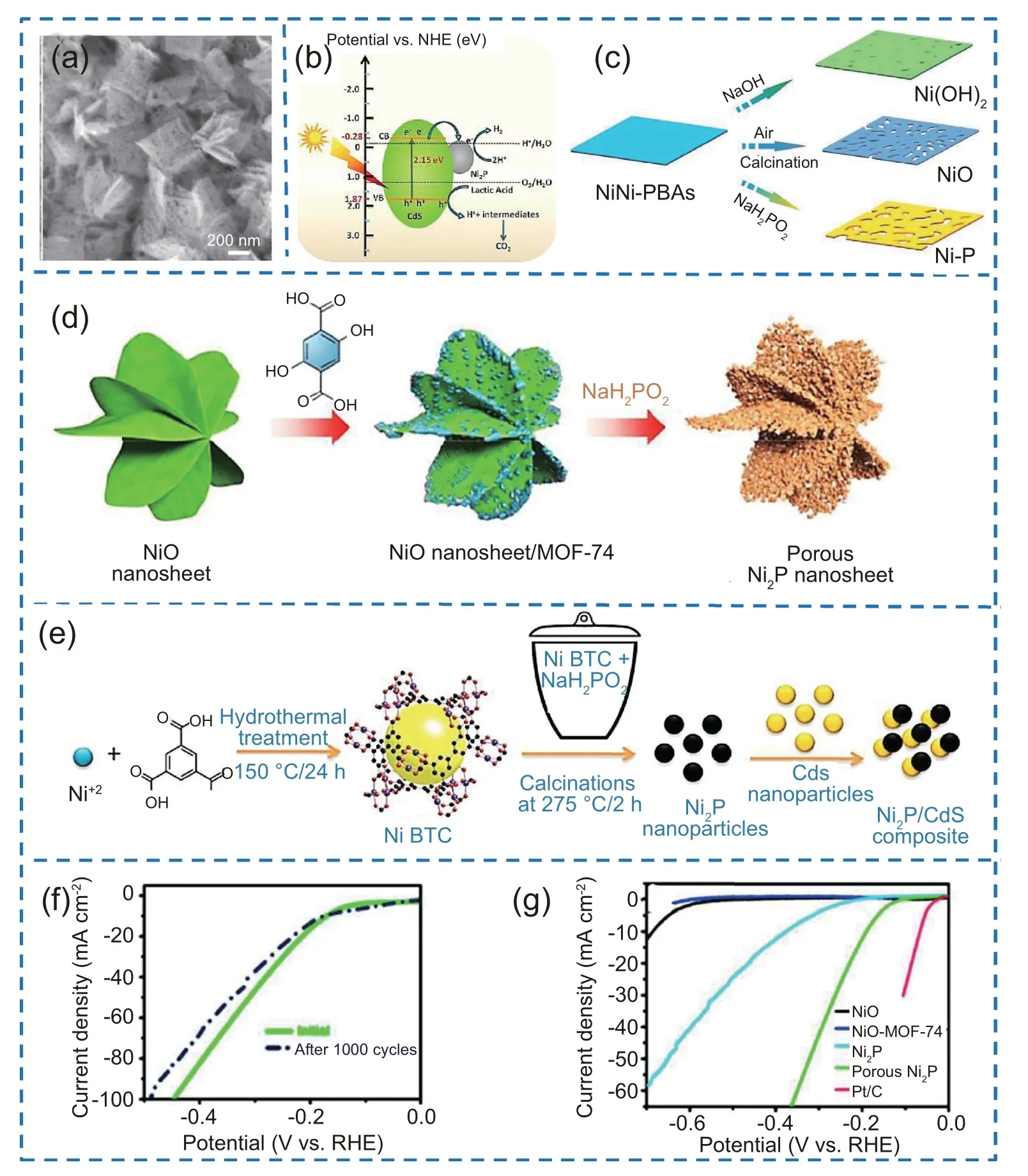
Fig.6.(a) Imaging of FESEM of porous Ni-P nanorods.(b)The reaction mechanism of Ni2P/CdS.(c) The NiNi-PBA scheme for the formation of Ni-P porous nanoplates.(d)Process diagram of preparation of porous Ni2P nanocrystals.(e)Synthesis of Ni-phosphide derived from Ni-BTC MOFs and synthesis of Ni2P/CdS composite.(f) Cyclic stability of porous Ni2P nanocrystals in 1.0 mol L-1 KOH.(g) LSV polarization curve.(a,c) Reprinted with permission from Ref.[100]Copyright 2016,The Royal Society of Chemistry.(b,e)Reprinted with permission from Ref.[117]Copyright 2016,American Chemical Society.(d,f,g)Reprinted with permission from Ref.[101] Copyright 2018,The Royal Society of Chemistry.
Thesynthetic methods and performanceapplicationsofMOFderived Cu-based phosphide composites materials are described above.MOFs derived Cu-based phosphide composites have large catalytic surface areas,and good long-term durability and efficiency.Thus,MOF-derived Cu-based phosphide composites are effective OER and HER catalysts.The largecatalytic surface area of MOF-derived Cu-based phosphide composites can accelerate the catalytic reaction rate to provide good electrocatalytic activity.Inaddition,gooddurabilitycan increase thelifeofthecatalyst and reduce replacement costs.High efficiency decreases the reaction time,which allows data to be acquired more quickly and results to be distributed more efficiently.The above properties describe the performance advantages of MOF-derived Cu-based phosphide composite materials in electrocatalysis.
2.2.MOF-derived bimetallic phosphide composite
2.2.1.Bimetallic phosphides

Fig.7.(a) The synthesis process diagram of Fe-No-P/rGO-T composites.(b) Graphitized carbon encapsulation FeP synthesis process diagram.(c) The synthesis process of FeP nanoparticles prepared by FePNC.(d) Scanning electron microscope SEM image.(e) SEM images of FePNC.(f) Comparison of SIBs electrochemical performance between FePNC and FePCM.(g)Cyclic performance and SIBs electrochemical performance of FePCM and FePNC at 200 mA g-1.(a,d)Reprinted with permission from Ref.[111] Copyright 2017,American Chemical Society.(b) Reprinted with permission from Ref.[102] Copyright 2018,The Royal Society of Chemistry.(c,e,f,g) Reprinted with permission from Ref.[103] Copyright 2018,Elsevier.
In addition to the role of MOF-derived single metal phosphides in catalysis,the catalysis of MOF-derived bimetallic metal phosphides also have been explored.These materials have larger specific surface areas than single-metal materials and exhibit better catalytic performance [119].Hao and coworkers [105] have designed and effected a simple MOF template phosphating method for the preparation of CoxFe1-xP nanocrystals.A well-defined architecture is achieved by using MOFs as a template and phosphating agent.A proper phosphating temperature and the addition of a binary exchange metal improve the performance.An important result is the observation that precut Co0.59Fe0.41P nanocrystals exhibit optimal kinetics at 450°C in both acidic and alkaline media by exhibiting a high exchange current density,small Tafel slopes,and a low initial overpotential,which indicated that Co0.59Fe0.41P nanocrystals had excellent electrocatalytic activity.Zou and co-workers [112] used nickel-iron PBA nanocrystals as precursors and templates to synthesize new,hollow bimetallic phosphide nanostructures by a simple phosphating procedure.The resulting (Ni0.62Fe0.38)2P hollow nanocubes indicate superior OER performance in an excellent alkaline medium due to a large surface area,good structural advantages,and a synergy between Ni and Fe sites,which affords a lower potential,smaller Tafel slopes,and good durability.These excellent properties define (Ni0.62Fe0.38)2P hollow nanocubes as a good candidate for potential OER applications to replace IrO2.Fig.9b depicts the synthesis of PBA nanocrystals with different Ni/Fe ratios.Ni(NO3)2·6H2O,K3[Fe(CN)6],and Na3C6H5O7·2H2O are bathed in water at 40°C in the first step.The resulting Ni-Fe PBA cubes are phosphatized at 350°C in the second step and directly converted into (NixFe1-x)2P nanocrystals.
MOF-derived bimetallic phosphides have intermediate porous structures,low overpotentials and take-off potentials,small Tafel slopes,high exchange current densities,and high durability and stability,which are important factors in their good OER and HER catalytic activity.Among these properties,the intermediate porous structures of MOF-derived bimetallic phosphides possess large specific surface areas that promote electrolyte diffusion and bubble release and improve catalytic activity.The high stability of MOF-derived bimetallic phosphides is due to their high conductivity,which promotes electron transfer,redistributes the valence states,and improves reaction kinetics in the process of water oxidation.Prolonged durability is also an important factor in maintaining high catalytic activity in practical applications.The presence of two active sites provides more electron-donor capacity through the synergistic action of the binary metals,which causes the catalytic activity of MOF-derived bimetallic phosphide catalysts to be significantly greater than that of single metal catalysts.This behavior provides a research basis for the future application of MOF-derived bimetallic phosphide catalysts in catalysis.
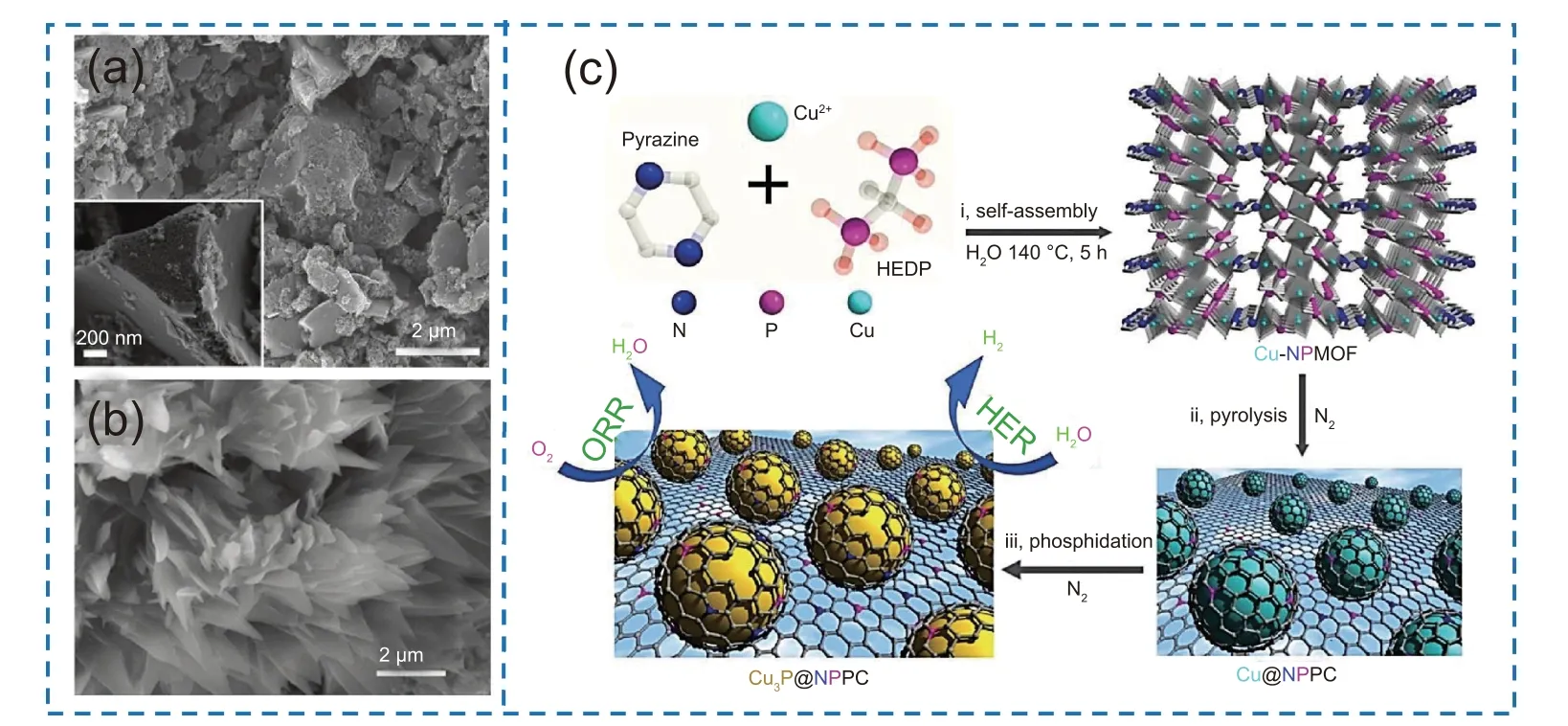
Fig.8.(a) The SEM image of Cu3P@NPPC.(b) The SEM image of Cu3P/C.(c) Manufacturing process diagram of Cu3P NPs coated with Cu3P@ NPPC.(I)Synthesis of Cu-NPMOF;(II)The carbonization of Cu-NPMOF resulted in Cu@NPPC;(III)The phosphorization of Cu@NPPC resulted in Cu3P@NPPC catalyst.(a,c)Reprinted with permission from Ref.[104]Copyright 2017,Wiley-VCH.(b)Reprinted with permission from Ref.[118]Copyright 2019,American Scientific Publishers.
2.2.2.Bimetallic phosphide composite
Early attempts by using MOF-derived bimetallic metalphosphide materials as catalysts have been reported by Jahan and co-workers [120].The results show that adding proper amount of rGO sheet can affect the crystallization process of MOF and improve the electrocatalytic performance of the composites.As shown in Fig.9a,Fe-MOFs are inserted into a rGO layer,wherein graphene serves as an excellent electronconducting substrate.It demonstrates how the graphene sheets are inserted into the porphyrin network as a means of synthesizing the graphene-porphyrin MOF:(I) r-Go sheets are combined by 4-(4-aminophenyl)pyridine diazotization to synthesize the G-dye;(II) testosterone cyclopentylpropionates(TCPPs) are used to synthesize the (Fe-P)n-MOF and Fe ion;(III) the (G-dye-FeP)n-MOF is synthesized by the reaction of(Fe-P)n-MOF with the G-dye.
Furthermore,a MOF-based strategy to synthesize Ni-Co LDH,NiCoP,and a NiCoP/C nanobox as electrocatalysts for ZIF-67 nm-scale copper oxide precursors have been developed by He and co-workers [113].In order to obtain 10 mA cm-2,an overpotential of 330 mV is required for NiCoP/C nanoboxes,which is lower than 370 mV for NiCoP nanoboxes and 420 mV for NiCo LDH nanoboxes.In addition,the Tafel slope of NiCoP/C nanoboxes is 96 mV dec-1compared with the 115 mV dec-1of NioP nanoboxes and the 135 mV dec-1of NiCo LDH nanoboxes,which indicates that NiCoP/C nanoboxes have superior OER activity and good stability.The result shows that NiCoP/C nanoboxes have greater electrocatalytic OER activity than Ni-Co LDH and NiCoP nanoboxes,because of their structural and compositional advantages.The synthetic procedure for MOF-based nanocomposite nanobox formation is shown in Fig.10b ZIF-67 nanocrystals react with Ni(NO3)2at room temperature to form Ni-Co LDH on their surfaces.Finally,the nanoboxes converted into a nickel-cobalt mixture of metal phosphides.NiCoP/C nanocomposites exhibit superior electrochemical behavior as OER electrocatalysts.

Fig.9.(a) Chemical structure diagrams and enlarged view of layers for rGO,G-dye,and (G-dye-FeP) N-MOF.The route of graphemeporphyrin MOF synthesis was shown:(I)G-dye synthesis by rGO table via diazoylation of 4-aminostyryl;(II)TCPP and Fe ions were synthesized by reaction(G-dye-FeP)nMOF;(III)the(G-dye-FeP)n-MOF is synthesized by the reaction of(Fe-P)n-MOF with the G-dye.(b)Schematic drawing(NixFe1-x)2P nanocubes.(a)Reprinted with permission from Ref.[120] Copyright 2012,American Chemical Society.(b) Reprinted with permission from Ref.[112] Copyright 2017,The Royal Society of Chemistry.
Different from the study of He and co-workers,Yan and coworkers [106] reported a simple,controllable synthesis of bimetallic Ni-Co-phosphide nanotubes using bimetallic organic framework precursors,which can be used as high efficiency electrocatalysts to achieve the complete pyrolysis of water.When the current density is 10 mA cm-2,the overpotential is 129 mV,respectively.The results indicate that Co4Ni1P nanotubes have significant catalytic activity for HER.In the same condition,the overpotential is 245 mV.This also indicates that Co4Ni1P nanotubes have significant catalytic activity for OER.The Co4Ni1P nanotubes have large specific surface areas,high porosity,and high carbon conductivity and display the synergistic effect of NiCoP and Co2P in their nanotube morphology.Fig.10c shows the polarization curve(jV) obtained by iR-corrected linear scan voltammetry.Fig.10d shows the polarization curves for CoP,Ni2P,and the bimetallic phosphides after iR-correction.The electrocatalytic HER activity of Co4Ni1P NTs is best for CoP,Ni2P,and other bimetallic phosphides.
Another example for NiFeP nanorods prepared from MIL-88-Fe2Ni MOF by low temperature phosphorization is described by Du and co-workers[107].Compared with NiP2and FeP,NiFeP nanorods retain the size and shape of the MIL-88-Fe2Ni MOF precursor and exhibit good electrochemical performance and a smaller overpotential.The nanorod-like NiFeP has good electrocatalytic properties in alkaline media,because of the synergistic effect ofNiP2and FeP.The preparation of NiFeP nanorods as shown in Fig.10a comprises three steps.First,MIL-88-Fe2Ni MOF nanorods are synthesized hydrothermally.The MIL-88-Fe2Ni MOF nanorods are then annealed in air at 450°C for 6 h to formNiFe2O4nanorods.Finally,NiFeP nanorods are synthesized by a low-temperature phosphating procedure with NaH2PO2as the phosphorus source.
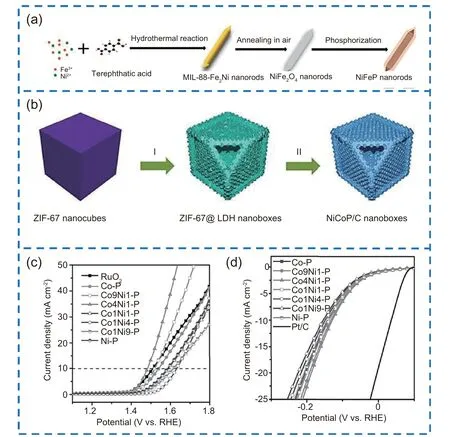
Fig.10.(a)Synthesis of NiFeP nanorods.(b)Formation process of NiCoP/C nanorods:(I)ZIF-67 nanorods react with Ni(NO3)2 to form ZIF-67@LDH nanorods;(II)ZIF-67@LDH nanorods phosphating to produce NiCoP/C nanorods.(c) The polarization curve of HER compared with single metal and bimetal phosphides.(d) The polarization curves for CoP,Ni2P,and the bimetallic phosphides after iR-correction.(a) Reprinted with permission from Ref.[107] Copyright 2018,Elsevier.(b) Reprinted with permission from Ref.[113] Copyright 2017,Wiley-VCH.(c,d) Reprinted with permission from Ref.[106] Copyright 2017,Wiley-VCH.
In order to study the efficient Ni5P4/Fe3P n-type carbon OER electrocatalysts,Zhang and co-workers [114] developed an MOF-derived phosphating protection method for preparing hollow nanocubes.At 250 mA cm-2,the N-doped C/Ni5P4/Fe3P hollow nanocubes exhibit outstanding long-term stability,mechanical durability,and electrocatalytic activity.As shown in Fig.11a,their cubic morphology is retained during the high-temperature phosphating process,which indicates the beneficial effect of the protective SiO2layer.The SEM image in Fig.11b shows the product to be highly concentrated nanoparticles rather than a cubic material protected by SiO2.The N-doped C/Ni5P4/Fe3P nanocrystals and hollow N-doped C/Ni5P4/Fe3P·Ni3[Fe(CN)6]2·H2O nanocrystals of uniform size are prepared by simple chemical precipitation at room temperature in Fig.11c.In the former procedure,N-doped C/Ni5P4/Fe3P nanocrystals are obtained by direct phosphorization at high temperature.In the latter procedure,an inert SiO2protective shell is applied to form hollow nanocrystalline Ndoped C/Ni5P4/Fe3P before phosphorization.The SiO2shell on the product surface is subsequently removed by HF etching.
Subsequently,MoFeP-PC (PC,phosphorus-doped carbon)microspheres have been obtained by Chen and co-workers[89].They used a simple one step pyrolytic and phosphorization of MOFs,which acts as an economic catalyst for the electrocatalytic nitrogen reduction reaction (NRR).MoFe-PC catalyst inherits the advantages of multi-component active site and porous structure of MOF precursor.Compared with reversible hydrogen electrode,the catalyst has higher Faraday efficiency under acidic conditions.In addition,Mo,PC in the product are active in NRR,synergistically improve the performance of NRR.Therefore,the catalyst has good electrocatalytic activity in NRR.
Almost aspects of MOF-derived bimetallic phosphide composites can be understood from the synthesis methods,morphological characterization,and performance applications mentioned above.Their porous structures provide more active sites that enhance electrocatalytic performance.The large specific surface area provides greater availability for electrochemical reactions,which accelerates reactions and increases catalytic activity.High conductance accelerates charge transfer and is beneficial to OER and electrocatalytic activity.The abundant active sites of MOF-derived bimetallic phosphide composites also are an important factor in their electrocatalytic performance.The cooperative effect of different metal phosphides in nanocomposites helps to enhance electrocatalytic activity.Carbon doping increases the rate of charge transfer and the conductivity of MOFs.
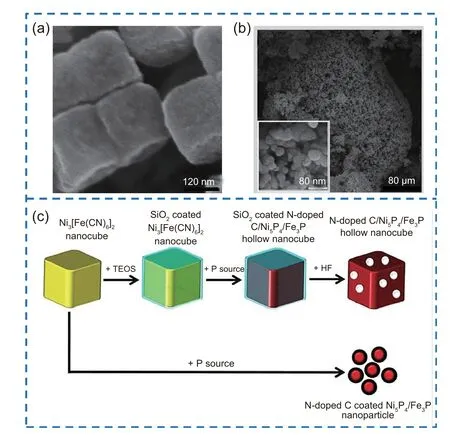
Fig.11.(a) SEM images of SiO2 coated N-doped C/Ni5P4/Fe3P hollow nanotubes.(b) SEM images of N-doped Ni5P4/Fe3P nanoparticles.(c) Synthesis process diagram of N-doped C/Ni5P4/Fe3P hollow nanotubes and N-doped C-coated Ni5P4/Fe3P nanoparticles.(a,b,c)Reprinted with permission from Ref.[114]Copyright 2017,The Royal Society of Chemistry.
The above information establishes the synthesis and performance characteristics of MOF-derived bimetallic phosphides and their composite materials.These substances display a large specific surface area,hollow porous structure,low initial potential requirement,high electrical conductivity,long-term stability,and durability.These properties explain the good catalytic activity of MOF-derived bimetallic phosphides and their composite materials in the OER and HER.The hollow porous structure provides structural stability,the large surface area speeds turnover by affording more space for reactions to occur,and their long-term stability and durability contribute to superior electrocatalytic performance.The above characteristics demonstrate the extensive application of MOFderived bimetallic phosphides and their composite materials in the field of electrochemistry and their prospects for broad application in the field of electrocatalysis.
2.3.Other MOF-derived metal phosphide
We have also found that MOF-derived materials mixed with multiple metals can enhance catalytic activity and create a very efficient catalyst[121].In previous attempts,Reddy and co-workers [122] have been reported MOF-derived materials with other metal phosphides.They synthesized a porous multicomponent transition metal phosphide from a layered bi-hydroxide double-shelled nanomaterial using a MOF templating strategy.The new multicomponent transition metal phosphides[MCTMP] nanostructure synthesized from semiconducting CdS nanorods displays high HER catalytic activity.The high specific surface area and large number of electron-hole pairs lead to better light absorption and a greater charge separation efficiency,which significantly improves catalytic performance.The three-step synthesis of CdS/MCTMPs nanocomposites is shown in Fig.12c.In the first step,the ZIF-67 diamond dodecahedron is used as a template to prepare multilayered double-hydroxide-shell TMP nanostructures.Semiconducting CdS nanorods are prepared by a hydrothermal method in the second step.The final step involves the synthesis of CdS/MCTMPs nanocomposites by homogeneous chemical precipitation.Weng and co-workers [108] have developed a very active HER catalyst comprising Co-and Wbased MOF ({[W(CN)8](SCN)3Co3(C13H14N2)6}N) nanowire precursors with S-doped CoWP nanoparticles inserted into the(S,N) doped carbon matrix.A stable current density is maintained for more than 40 h in constant-potential stability tests in acidic and alkaline electrolytes,which is the best catalytic performance among all known carbon composites and TMPs.As shown in Fig.12a,their material shows the formation of the CoWP nanoparticles.Fig.12b illustrates the process whereby S-CoWP @S,N-C nanowires doped with S are transformed into nanowires in the carbon (S-CoW@(S,N)-C)matrix doped with S and N by pyrolysis at 700°C and phosphorization at 400°C.It also clearly confirms that the SCoWP@(S,N)-C product maintains a good nanowire morphology in Fig.12d-e.The nanowires range in diameter from 100 to 300 nm,making them thinner than the CoW-MOF nanowires.Fig.12f shows the excellent electrocatalytic performance of S-CoWP@(S,N)-C in 1.0 mol L-1KOH.They demonstrates the electrocatalytic properties of SCoWP@(S,N)-C nanowires in an acidic solution in Fig.12g.The electrocatalytic performance of CoWP@N-C nanowires with a mass load of 0.71 mg cm-2is not as good as that of SCoWP@(S,N)-C in acidic and alkaline medium,because Sdoping in a metal phosphide or carbon regulates the electron donor-acceptor process and improves catalytic activity.
The catalytic applications of MOF-derived materials with other metal phosphides can be described from the standpoints of synthesis methodology,morphological characterization,and performance application.MOFs with other metal phosphides exhibit durability and long-term stability in catalysis due to the large surface area of electron-hole pairs,good light absorption capacity,and high separation efficiency.These qualities greatly improve photocatalysis [123] and electrocatalysis.In addition,MOF-derived metal phosphides with other metals can be phase synthesized into new composites with improved catalytic properties.For example,the joint synthesis of MOFderived materials with other metal phosphides and CdS produces a composite with a large CdS surface area that provides more efficient adsorption,enhanced carrier transport to a lot of active sites,reduced material degradation,and high electrontransfer efficiency.We also find that MOF-derived materials with other metal phosphides can further improve their catalytic activity when mixed with heterozygotes.For example,the incorporation of carbon materials effectively adjusts the core-shell nanostructures formed by heteroatomic doping and encapsulation of transition-metal nanoparticles.Accordingly,the preparation of MOF-derived composites with other metal phosphides yields efficient and inexpensive solar catalysts.These materials display excellent photo-and electrocatalytic performance,which enhances their prospects for applications and further research in the field of catalysis.
2.4.Summary
As dual function catalysts with good catalytic activity in HER and OER,MOF-derived metal-phosphide composite materials exhibit excellent catalytic performance based on their highly porous structure,large specific surface area,high conductivity,good stability,and good durability.Most of these materials are employed in the electrocatalysis of water with only a small fraction devoted to the photocatalysis of water.MOFs derived metal-phosphide composites have enhanced OER and HER activity and can be used as efficient,bifunctional catalysts.In addition,MOF-derived metal-phosphide composites can be prepared from inexpensive,abundant materials,which achieves the goals of low cost and efficient catalysis.In addition,they perform well in electrochemical catalysis by promoting faster and cleaner reactions,which solves the problem of poor reaction efficiency.MOF-derived metal phosphides and their composite materials have extensive promise in the field of electrochemistry by serving as efficient bifunctional catalysis.

Fig.12.(a)The white circle shows the structure of the CoWP nanoparticle encapsulated by S and N doped carbon.Different colors of the ball represent different atoms.H tends to be absorbed on the S,N-C shell,but not on the S-CoWP core.The red dotted line indicates where the carbon is absorbed.(b) The synthesis process diagram of S-CoWP@S,N-C.(c) Schematic diagram of the synthesis process of layered double-hydroxide double-shell nanocage CdS/MCTMPs nanostructure,and hydrogen production under simulated sunlight with nanocomposite material as photocatalyst and lactic acid as sacrificial agent.(d)SEM images of S-CoWP@S,N-C nanowires.(e) Low-power SEM images of S-CoWP@S and N-C nanowires.(f) Electrochemical characterization of S-CoWP@S,N-C nanowires,CoWP@N-C nanowires and Pt/C electrocatalysts in 1.0 mol L-1 KOH.(g)Electrochemical characterization and polarization curves of S-CoW@S,NC nanowires,S-CoWP@S,N-C nanowires,S,N-C nanowires,CoWP@N-C nanowires and Pt/C electrocatalysts prepared at different temperatures in 0.5 mol L-1 H2SO4 solution.(a,b,d,e,f,g)Reprinted with permission from Ref.[108]Copyright 2018,American Chemical Society.(c)Reprinted with permission from Ref.[122] Copyright 2016,The Royal Society of Chemistry.
3.Batteries
A battery is a device containing an electrolyte and metal electrodes that convert chemical energy into electrical energy[124,125].The performance of the battery is mainly determined by the positive and negative polarities [126].Common examples are dry batteries,lead batteries,and lithium-ion batteries (LIBs) [127,128].LIBs have the characteristics of small size,light weight and large specific capacity.They have attracted widespread attention for electrochemical energy storage.Graphite is the electrode material currently used in commercial batteries [129].New electrode materials are needed to replace carbon and meet increasing performance requirements.MOFs can be used as an electrode material in batteries due to their qualities of good channel structure,low cost,controllable pore size,flexible structure,and good reducing activity,whereas MOF-derived metal phosphides also can be used as an electrode material to further overcome existing disadvantages [130-135].For example,Li and coworkers [136] described how MOF-derived metal composite materials can improve lithium storage capacity by serving as a better electrode material for LIBs.Recently,MOF-derived metal phosphides have been used as the cathode,anode,and electrolyte in LIBs.Fig.13 shows a schematic diagram of the battery aspects of MOF-derived metal phosphides in terms of synthetic methodology,morphology,and performance application.In addition,the performance of MOF-derived metal phosphides in the battery is shown in Table 3.
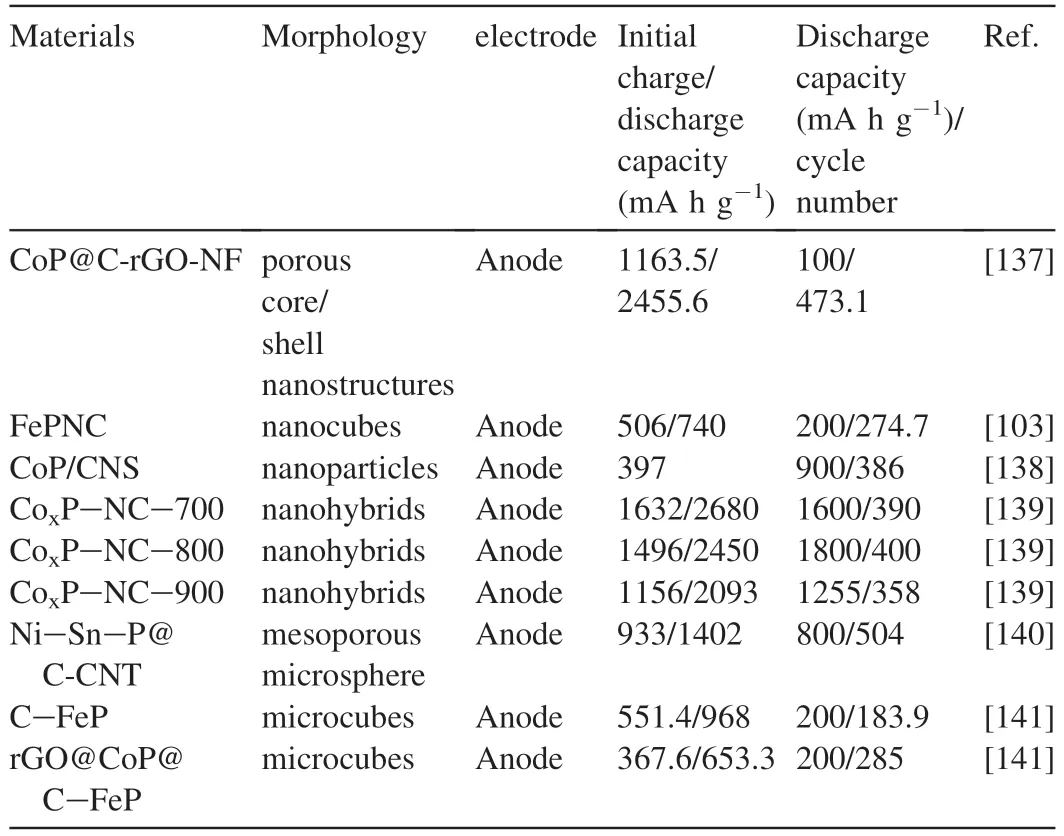
Table 3 MOFs derived metal phosphide materials as anodes for batteries.
3.1.MOF-derived single-metal phosphide
3.1.1.Cobalt-phosphide composite
MOF-derived cobalt-phosphide composites as electrode materials in recent years is developed by Ge and co-workers[137].They prepared core/shell CoP@C polyhedrons derived from ZIF-67 by a low temperature phosphating process that uniformly anchored the materials to the rGO network.At the current density of 100 mA g-1,the synergistic performance of rGO and CoP@C maintained the specific capacity of 473.1 mA h g-1for 100 cycles,showing excellent electrochemical storage performance.The core/shell structure also reduces the volume changes caused by chemical reactions and provides sufficient buffer space,while the carbon shell effectively prevents CoP particles from decomposition and aggregation.Fig.14a-b shows the even distribution of CoP@C polyhedra with an average size of 800 nm and the wellmaintained morphology of ZIF-67.As shown in Fig.14c,they describe the synthetic diagram of the CoP@C-rGO-NF layered network.Nickel foam(NF)is first thoroughly stirred in PDDA solution to give it a positive charge and then immersed in GO solution to form a three-dimensional GO network on NF.The 3D GO-NF network is immersed in a methanol solution of Co2+and 2-methylimidazole.Due to the synergizing effect of Co2+and the O-functionality on the GO nanosheets,polyhedral ZIF-67 particles nucleate and grow evenly on the surface.A CoP@C-rGO-NF hierarchical network is obtained by carbonization and phosphorization.They show the rate capacity of CoP@C-rGO-NF at current densities of 100-1600 mA g-1in Fig.14g.As shown in Fig.14h,cycle performance and coulomb efficiency are obtained at current density of 100 mA g-1.Xia and co-workers[139]developed a self-templating strategy based on MOFs to facilitate the synthesis of CoxP-NC hybrids with adjustable combinations.CoxP nanoparticles were uniformly embedded in a N-doped carbon matrix.The CoxP-NC-T nanocomposites exhibit good electrochemical properties as positive electrode materials.It also clearly displays the buffer diagram cor111responding to the carbon matrix during CoxP-NC charging and discharging in Fig.14d.The CoxP nanoparticles are synthesized and sealed in situ and uniformly carburized in the carbon network,which provides an effective channel for ions and enough space for volume expansion during the cycling process.Fig.14e shows the CoxP-NC composite mixed with 100 mg ZIF-67 and 50 mg red phosphorus.The mixture is heated to the desired temperature at 2°C min-1and placed under nitrogen for 2 h to produce CoxP-NC-T.As shown in Fig.14f,they describe the relationship between the reversible charging and discharging capacities of CoxP-NC-900,CoxP-NC-800,and CoxP-NC-700 and the cycle times at a current density of 0.1 A g-1.The CoxP-NC-800 electrode exhibits stable cycling and a high charging capacity of 1224 mA h g-1after 100 cycles,because CoxP-NC-800 is present as a two-phase combination of Co2P and CoP.

Fig.13.A schematic diagram of MOFs derived metal phosphides in the aspect of battery.
To improve electrochemical properties,Zhang and coworkers[138]synthesized CoP nanoparticles by homogeneous impregnation of nitrogen-doped C nanosheets (CNSs) via a simple one-step calcination.CoP/CNS composites (CoP-O)have a small particle size and obvious chemical interactions.At 100 mA g-1,the storage capacity is 598 mA h g-1,and the contribution of the CoP capacity is 831 mA h g-1.At a current density of 20 A g-1,the material maintains a capacity of 174 mA g-1(the CoP contribution capacity is 294 mA g-1).The high rate and long cycling capacities of CoP/CNS composites are derived from their chemical reaction with PVC and the high conductivity of CNSs.Fig.15a shows that graphitization promotes electron transfer,while the C-P bond enhances the CoP-to-CNS contact.As shown in Fig.15b,they describe the sample to contain a large number of nanoparticles embedded in CNSs.It also clearly shows the TEM image of CoP-O after 500 cycles in Fig.15c.The CoP nanoparticles are evenly distributed in the CNSs,indicating that the latter environment facilitates hundreds of cycles with the CoP nanoparticles.Fig.15d describes the synthesis of CoP-T and CoP-O.In one case,a Co-MOF and red P are calcined at 700°C for 2 h,and CoP-O is calcined in an Ar atmosphere.In the other case,Co-MOF is calcined at 700°C for 2 h,and CoP-O is calcined in an Ar atmosphere.Co@C and red P are calcined at 700°C for 2 h,and CoP-O is calcined in an Ar atmosphere.They compare the rate performances of CoP-T and CoP-O in Fig.15e.The discharge capacity of CoP-O is greater than that of CoP-T.Fig.15f compares the cycle performances of CoP-T and CoP-O at 100 mA g-1,where the discharge capacities of CoP-T and CoP-O at 200 cycles are 252 and 498 mA h g-1,and capacity cycle efficiency of 83.3 and 40.7%,respectively.

Fig.14.(a,b) SEM image of CoP@C-rGO-NF.(c) CoP@C-rGO-NF synthesis process.d,e) CoP@C-rGO-NF: (d) Schematic diagram of buffer environment provided by carbon matrix during charging and discharging.(e) CoxP-NC polyhedron formation process diagram.(f) Cycling performance of Cox-NP-700,Cox-NP-800 and Cox-NP-900 electrodes.The tests were performed at current densities between 0.1 A g-1,and voltages between 0.01 and 3.0 V.(g)CoP@C-rGO-NF anode rate capability.(h)Cycle performance and coulomb efficiency when current density is 100 mA g-1.(a,b,c,g,h)Reprinted with permission from Ref.[137]Copyright 2016,Elsevier.(d,e,f) Reprinted with permission from Ref.[139] Copyright 2017,The Royal Society of Chemistry.
As mentioned above,MOF-derived cobalt-phosphide composites have excellent properties as electrode materials due to their high charge capacity,high rate,excellent cycle stability,and good storage performance.In addition,rGO nanosheets provide sufficient surface area to load the active material,which reduces the reversible capacity of the mixed electrode and greatly improves the coulomb efficiency,storage capacity,and cycling performance.The conductivity and CoPload content are greatly improved in the process.CNSs have the excellent electrochemical property of high conductivity,which can enhance the conductivity of MOF-derived cobalt phosphides,and also prevent the aggregation of nanoparticles and increase the conductivity and the number of active sites.Additionally,they maintain the carbon mesh integration and long-term circulation,thereby leading to stable cycling performance.MOF-derived cobalt phosphides and their composites have been synthesized under a variety of conditions.They have excellent electrochemical properties with respect to batteries.
3.2.MOF-derived bimetallic phosphide composite
In previous attempts,MOF-derived bimetallic phosphide composites as battery electrode materials have been reported by Dai and co-workers [140].They reported a two-step solvothermal reaction of the Ni-Sn-BTC MOF to produce Ni-Sn-P@C-CNT and Ni-Sn-P@C (Fig.16b).The Ni-BTC MOF microspheres were synthesized by a microwave heating method.The Ni-Sn-BTC MOFs were obtained by a Sn-based ion-exchange process and converted into carbon-coated Ni-Sn@C-CNT structures in carbon nanotubes.Carbon nanotube formation was catalyzed by Ni and Sn in situ in a C2H2/Ar atmosphere.Ni-Sn-P-C-CNT microspheres were prepared by phosphorization.Ni-Sn@C microspheres were calcined under Ar and transformed into Ni-Sn-P-CNT microspheres by a phosphorization process.The SEM of Ni-Sn-P@C reveals the presence of solid microspheres with rough surfaces rather than the yolk-shell structure in Fig.16a.This behavior may result from thermal expansion of the yolk during phosphorization.Fig.16c displays the cycling performance of Ni-Sn-P@C-CNT,Ni-Sn-P@C,and Ni-Sn@C-CNT at 100 mA g-1.The Ni-Sn-P@C-CNT electrode describes as table response during repeated cycles,despite a slight ramp at the beginning of the experiment.Fig.16d depicts the rate capacities of the Ni-Sn-P@C-CNT and Ni-Sn-P@C anodes at current densities of 0.1-5 A g-1.Compared with Ni-Sn-P@C,Ni-Sn-P@C-CNT shows greater capacitance and stability.The Ni-Sn-P@C-CNT electrode in Fig.16e also was cycled 800 times.Over this period,there is almost no capacity attenuation,and the final capacity remains at 504 mA h g-1,which is indicative of a high rate and cycling stability.
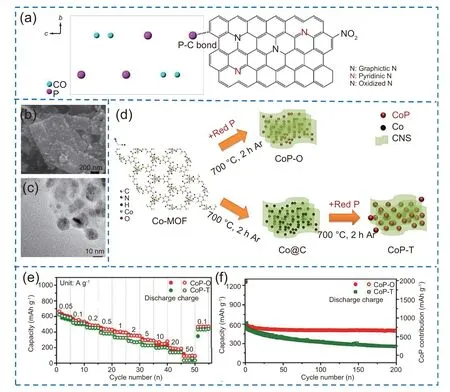
Fig.15.(a)Schematic diagram of CoP-O.(b)The sample contain a large number of nanoparticles embedded in CNSs.(c)TEM images of CoP-O after 500 cycles.(d)Schematic diagram of the process of synthesizing nanocop embedded in CNSs.(e)Performance display diagrams of CoP-O and CoP-T.(f)Typical CV curves of CoP-O,CoP-T,CoP-BM and bare CNSs at the scanning rate of 0.1 mV s-1.(a,b,c,d,e,f)Reprinted with permission from Ref.[138]Copyright 2017,Springer.
Different from the Wang and co-worker [142],Yang and co-worker[143]described a binderless ZnNiP electrode based on a Ni metal-organic framework.Under the condition of optimized zinc doping process,it has achieved good electrochemical performance in both zinc batteries and hybrid supercapacitors.The results show that as zinc battery,it has good durability.When used as a hybrid supercapacitor,it has excellent cycling performance and high energy density.In addition,it provides a new idea for MOF-derived bimetallic phosphide to the next generation of electrochemical energy storage structures,and has a wide range of applications in the field of electrochemistry.
3.3.MOF-derived materials with other metal phosphides
Li and co-workers [141] reported early attempts to use MOF-derived composites with other metal phosphides as electrode battery materials.Using PB as a reaction template,they prepared well-designed,porous nucleus-shell phosphating microcubes connected to one another by rGO nanosheets.Due to the synergistic effect of its unique structure and composition,the rGO@CoP@C-FeP composite demonstrates excellent electrochemical properties when used as a SIB negative electrode.In addition,the core-shell design contains sufficient buffer space during charging and discharging to provide structural stability to the active material.The carbon layer and rGO nanostructures of CoP provide high-speed channels for charge transfer and generate good rate capability.The synthetic progress of the rGO@CoP@C-FeP composite is shown in Fig.17a.Fig.17b shows the SEM image of the PBderived FeP microcube.The sample is composed of homogeneous nanoparticles with a size of about 400 nm,which illustrates the porous structure of the FeP product.As shown in Fig.17c,the SEM image of the CoP@FeP microcube in a Co(OH)2@PB composite with an average diameter of 500 nm,which clearly illustrates the core-shell structure of the CoP@FeP microcube in Co(OH)2@PB and the 50 nm shell thickness of CoP.Fig.17d shows the cycling behavior of rGO@CoP@C-FeP from 3.0 to 0.01 V vs.Na+/Na.The comparative cycling performance of the carbon nanotube electrode confirms that the reduced rGO and CoP shell play important roles in the discharge process.Fig.17e presents the rate properties of CoP@C-FeP,C-FeP,and rGO@-CoP@C-FeP electrode materials at different current densities(0.1-2 A g-1).The results show that rGO-CoP@C-FeP with rate capacity of 341.2 mA h g-1is stronger than CoP@C-FeP with rate capacity of 176.9 mA h g-1and Co@C-FeP with rate capacity of 32.9 mA h g-1at the condition of 2 A g-1.This result demonstrates the superior electrochemical performance of the rGO@CoP@C-FeP composite.
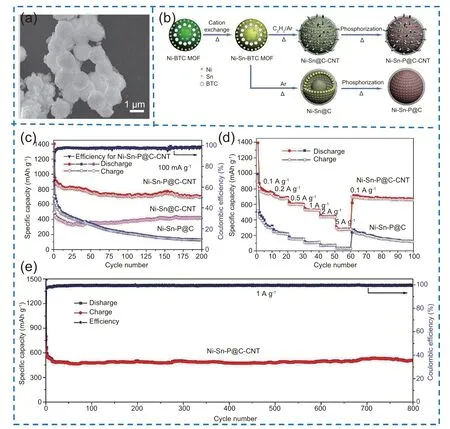
Fig.16.(a) SEM images of Ni-Sn-P@C.(b) Formation process diagram of Ni-Sn@C-CNT,Ni-Sn-P@C-CNT,egg yolk shell Ni-Sn@C and Ni-Sn-P@C.(c)Cycling properties of Ni-Sn-P@C,Ni-Sn-P@C-CNT and Ni-Sn@C-CNT composites at 100 mA g-1.(d) Rate capability of Ni-Sn-P@C and Ni-Sn@C-CNT composites at different current densities.(e)Long life cycle performance of Ni-Sn-P@C-CNT in 1 A g-1.(a,b,c,d,e)Reprinted with permission from Ref.[140]Copyright 2017,Wiley-VCH.
The MOF-derived Cu-based phosphide,MOF-derived bimetallic phosphide,and other metal-phosphide composites mentioned above play a vital role as battery electrode materials,because their large specific surface areas and highly porous structures produce excellent electrochemical performance in terms of high rate capability,good cyclability,and high catalytic activity.The large specific surface areas and porous structure of these materials create more active sites and improve reaction yields accompanied by good cyclability and reversible capacities.These properties establish the composites as prominent candidates for electrode battery materials.These qualities are enhanced by the synergistic effects of MOF-derived Cu-based phosphide,bimetallic phosphide,and other metal-phosphide composite materials.Moreover,these properties establish MOF-derived Cu-based phosphide,bimetallic phosphide,and other metal-phosphide composites as viable components in electrochemical applications and as subjects for further investigation.
3.4.Summary
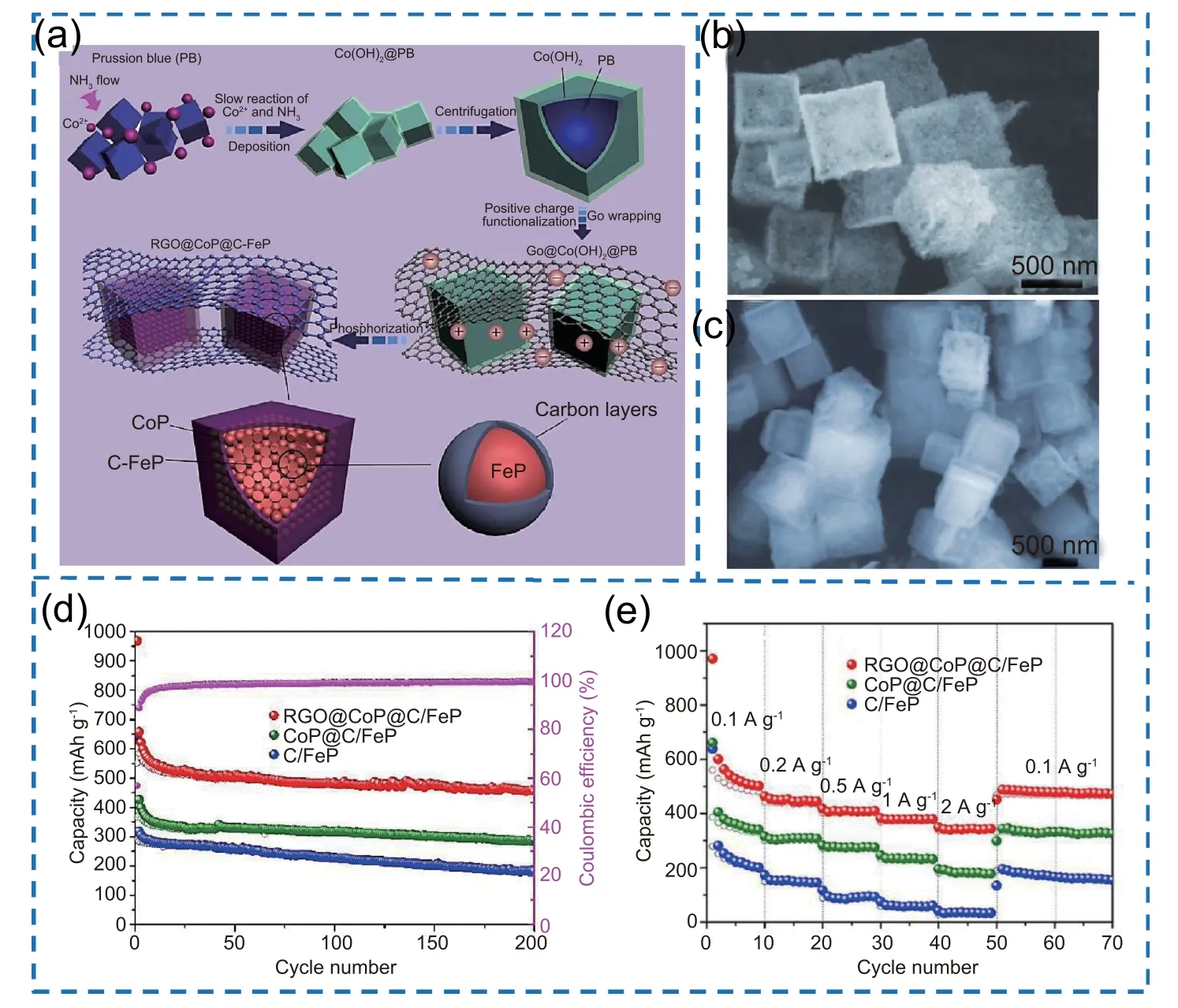
Fig.17.(a)Formation diagram of rGO interlinked core-shell structure rGO@CoP@C-FeP porous microcubes.(b)SEM image of PBA porous C-FeP microcube.(c)SEM images of CoP@C-FeP phosphated microcube composites with core-shell structure.(d)Cycle performance of rGO@CoP@C-FeP,CoP@C-FeP and CFeP.(e) Rate capability of rGO@CoP@C-FeP,CoP@C-FeP and C-FeP electrodes.(a,b,c,d,e) Reprinted with permission from Ref.[141] Copyright 2017,Elsevier.
MOF-derived metal phosphides composites as excellent electrode materials,because of their outstanding electrochemical properties including long cycling stability,high rate,electrochemical reversibility,large charge capacity,good storage performance,and structural stability.The abundant mesopores and large surface areas of MOF-derived metalphosphide composites provide space to buffer the large volume changes that occur during discharging and charging.Moreover,core-shell metal phosphides containing uniquely designed,interconnected rGO-nanosheet composites have excellent electrochemical performance that are superior to those of metal phosphides prepared by ball grinding or other methods.The porous structure of MOF-derived metal phosphide composites also shortens the lithium-ion diffusion distance,produces a larger electrode/electrolyte interface,facilitates greater lithium-ion inclusion,and provides the volume needed for lithium-ion release.These qualities illustrate the role of the synthetic reaction conditions in controlling the properties of MOF-derived metal-phosphide composites,which promote the widespread use and application of these materials in batteries.
4.Supercapacitors
Supercapacitors (SCs) are newly developed energy storage devices that occupy a niche between conventional capacitors and rechargeable batteries[144-156].SCs are composed of an electrode,separator,and electrolyte [157-159].The electrode is the key component.Traditional physical capacitors display good charging and discharging characteristics,but without a large storage capacity.Current research in electrochemical energy storage is seeking a device with light weight,high functional density,long cycle life,fast charging and discharging,and environmental compatibility for use in LIBs,capacitors,hybrid cars,and sensors.The electrode is the key factor determining the performance and storage capacity of SCs [160-164].Carbon is the most widely used electrode material and was the first material used to make SCs,but its capacitance is very low.Therefore,a new electrode material is needed to replace graphite and improve performance.One choice is MOFs [165],which are known for their adjustable pore size and large surface area.Subsequently,MOF-derived metal-phosphide composites possess unique electrochemical properties [166-175]and are readily obtainable in high yields using cheap starting materials [162,176-180].Ultrathin (2D)cobalt-organic-framework (Co-MOF) nanosheets synthesized by a one-pan water-thermal synthetic method assisted by surfactants possess excellent electrical properties,optical transparency,and stability and can be used to prepare low-cost electrodes and high-performance SCs[162].Metal phosphides are novel electrode materials that show excellent electrochemical properties when applied to SCs.However,this material still faces problems of poor multiplier performance and long-cycle instability,which restrict its large-scale application.Compared with single-metal phosphides,the electrochemical properties of bimetallic phosphides are greatly improved by introducing other ions to form bimetallic phosphides [181].Bimetallic phosphides exhibit a greater number of reduced active sites and significantly improved electrochemical conductivity and stability.Due to their high density,low cost,and large surface areas,MOFs are promising SC electrode materials.The storage characteristics of SCs are greatly improved by using MOF-derived bimetallic phosphides materials.Fig.18 presents a schematic diagram of MOF-derived bimetallic phosphides implementation in SCs,describing their synthetic methodology,morphological characterization,and applications.Table 4 lists the research results of MOF-derived bimetallic phosphides in SCs in recent years.

Table 4 MOFs derived phosphide composite materials for supercapacitors.

Fig.18.A schematic diagram of MOFs derived bimetallic phosphides in the aspect of SCs.
4.1.MOF-derived bimetallic phosphide composite
To produce a hollow yolk-shell Ni0.85Se|P microsphere,Zhang and co-workers [110] selenized and phosphatized a Ni-MOF with a carbon-containing metal mono-sulfide.The result described that Ni0.85Se|P is a good SCs material.The Ni0.85Se|P electrode has a high specific capacity of 506 C g-1at 1 A g-1in 2.0 mol L-1KOH and good battery characteristics.Hollow carbon-containing Ni0.85Se|P microspheres can be used as a good energy storage material in SCs and as an active HER material for energy conversion,thereby achieving dual function.Fig.19a contains the SEM image of Ni0.85Se|P.Ni0.85Se|P showing a uniform spherical shell distribution with an average outer-shell diameter of 2.17 μm.The Ni0.85Se|P shell is thinner than that of other samples,and the pellets inside the shell are clearly visible.The image indicates that selenization causes the rod-like surface of Ni-MOF to develop into a thin layer,where as phosphorization thins the shell layer of Ni0.85Se|P.The TEM image of Ni0.85Se|P.shows a uniform,hollow yolk-shells with a rough rod-or flake-like texture on the surface (Fig.19b).The average size is about 1.50 μm,and the solidified shell thickness is about 80 nm.The Ni0.85Se|P material has the thinnest shell and the smallest internal size.The synthesis of Ni0.85Se|P composite materials is shown in Fig.19c.A dark green transparent solution prepared in the early stage is transferred into an autoclave and heated for 14 h at 150°C to produce Ni-MOF.Selenium and red phosphorus are thoroughly mixed and placed in a tube furnace at 200°C for 10 min.Ni-MOF is added to the tube furnace and heated at 300°C for 1 h.In the end,the furnace is cooled naturally to normal temperature to yield the Ni0.85Se|P hybrid composite material.
Another example for MOF-derived bimetallic phosphide composites have been synthesized by Lv and co-workers[182],which is the electrode material in SCs.They prepared rGO/Ni2P composites by in situ phosphorization of a GO/MOF precursor.When the rGO/Ni2P composite is used in a SCs,its electrochemical behavior is better than that of pure Ni2P.When the rGO content is optimized at a specific volume ratio of 2rGO/Ni2P,the capacitance at 1 A g-1is 890 F g-1.Fig.19d shows the GCD results of Ni2P and x-rGO/Ni2P electrodes at a constant current density of 2 A g-1.The GCD profile exhibits a plateau region with two charge/discharge curves,which also illustrates the capacitance characteristics of the synthetic materials.As shown in Fig.19e,they describe the change in capacitances(Cs)with respect to current density for all electrodes.The 2rGO/Ni2P-based electrode has the largest Csvalue among the synthetic materials,with specific capacitances of 890,788.2,677.2,603.8,540.8,and 484 F g-1at 1,2,4,6,8,and 10 A g-1,respectively.A 54.4% specific capacitance value of the 2rGO/Ni2P composite electrode is retained,indicating its good rate performance.It also clearly shows the CV curve of 2rGO/Ni2P//AC hybrid supercapacitor[HSC] over a 0-1.5 V potential range in Fig.19f.The result indicates the good capacitance of 2rGO/Ni2P//AC.
4.2.Summary
For the synthesis of SCs,MOF-derived metal phosphides are prepared primarily by in situ phosphating and conventional selenide-phosphating processes.MOF-derived bimetallic phosphide composites perform better than pure MOF-derived metal phosphides and MOF-derived metal compounds as electrode materials,because the bimetallic MOF-phosphides show superior electrochemical properties of high capacity and good storage performance.As the crystallinity of the material is in creasedby pdoping and the surface electronic structure is adjusted,these composites can be used to prepare energy storage electrode materials and provide an important basis for the future research of MOF-derived metal phosphide composites in the field of SCs and batteries.

Fig.19.(a)TEM image of Ni0.85Se|P.(b)SEM image of Ni0.85Se|P.(c)Ni0.85Se|P hollow yolk shell ball formation process diagram.(d)GCD curves of Ni2P and xrGO/Ni2P as the electrochemical properties of supercapacitor electrodes at 2 A g-1.(e) Ni2P and rGO/Ni2P are used as the electrochemical properties of supercapacitor electrodes,where the specific capacitance is used as a function of current density.(f)Electrochemical performance of 2rGO/Ni2P//AC HSC devices:Ragone diagram.(a,b,c)Reprinted with permission from Ref.[110]Copyright 2019,Elsevier.(d,e,f)Reprinted with permission from Ref.[182]Copyright 2018,Elsevier.
5.Conclusions and outlook
In summary,we have reviewed the electrochemical applications of MOF-derived metal phosphide materials that included their use in catalysis,batteries,and SCs.Their synthesis,morphology,composition,and electrochemical properties are described.Compared with non-precious metal resources such as graphene,metal oxides,and carbon-based materials,MOF-derived metal phosphide materials have better electrochemical properties.MOFs combine with various metal ions and composites in different ways to achieve the large specific surface areas and effective active sites that enhance electrochemical performance.Metal phosphides derived from MOFs exhibit good catalytic performance that meets the requirements of high activity,low cost,and high efficiency.As electrode materials for batteries and SCs,their energy storage performance has been greatly improved.These qualities result from the uniform pore size distribution,high specific surface area,fine pore structure,and other structural characteristics of MOF-derived metal phosphides,which are accompanied by good capacity,catalytic activity,stability,and durability.However,some disadvantages exist that limit electrochemical applications.Because most MOFs have a charge-discharge cycle life of less than 10,000,and the column effect does not equal 100%.This cycle life limitation must be overcome.Therefore,it is necessary to continue to explore the electrochemical applications of MOF-derived metal phosphides to obtain materials with high stability and electrochemical activity.According to the published literature,the following challenges should be faced and met in the future:
1.Long-term durability and further overpotential reduction.Durability and low overpotentials are necessary conditions for effective catalysts and electrode materials.Low overpotentials promote improved product yields,and good durability increases catalyst lifetime,thereby lowering costs.Production of MOF-derived metal phosphides with improved electrochemical properties may be achieved by designing arrays of coated conductive nanowires or developing ternary TMPs using other transition metal elements as promoters.
2.Control the temperature of phosphating reactions.MOFderived metal phosphides are prepared by phosphating reactions.Temperature control of these reactions is particularly important,because an appropriate temperature is needed to prepare a crystal of suitable quality with a porous structure that enhances electrochemical properties.Elevated temperatures significantly influence the properties of synthesized MOF-derived metal phosphides when these materials are used as catalysts and electrode materials.Therefore,control of the temperature employed in synthesizing different MOFderived metal phosphides is important.
3.Stabilized particles and reduced particle aggregation.Heat treatment of materials often leads to a degree of particle aggregation,which will reduce the specific surface area and electrochemical effectiveness of MOF-derived metal phosphides and their composite materials.Therefore,an appropriate strategy is needed to prepare MOF-derived metal phosphides and their composite materials;particularly,such a strategy should stabilize particles,reduce particle aggregation,and increase the specific surface area and the number of reactive sites to improve electrochemical properties.
4.Design the crystal size of a specific morphology.By designing the crystal size of specific morphology,the electrochemical holes with high density unsaturated active sites and high efficiency diffusion path with low electrons can be obtained,so that higher discharge capacity and discharge performance can be obtained.At the same time,the specific capacity and rate of the electrode can also be improved,which can further improve the electrochemical performance of supercapacitors and batteries.
In summary,MOF-derived metal phosphides show great promise in the field of electrochemistry due to their unique properties.However,some problems and room for improvement still exist in the preparation and electrochemical application of MOF-derived metal phosphides.For example,the development of effective strategies for the mass production of MOF-derived metal phosphides will contribute greatly to their rapid use in practical electrochemical applications.
Conflict of interest
The authors declare that they have no known competing financial interests or personal relationships that could have appeared to influence the work reported in this paper.
Acknowledgment
This work was supported by the National Natural Science Foundation of China(U1904215),Natural Science Foundation of Jiangsu Province (BK20200044),Changjiang scholars program of the Ministry of Education (Q2018270).
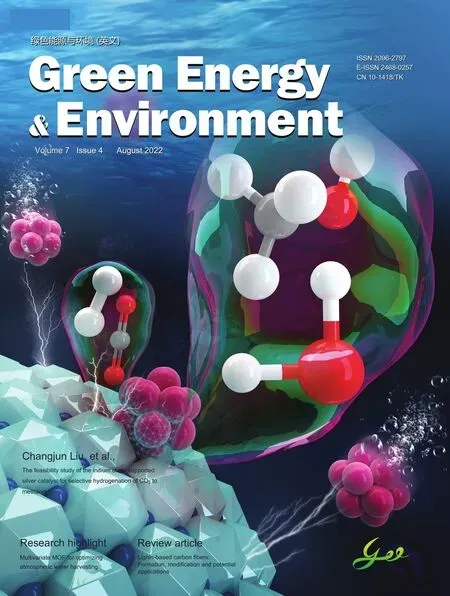 Green Energy & Environment2022年4期
Green Energy & Environment2022年4期
- Green Energy & Environment的其它文章
- Multivariate MOF for optimizing atmospheric water harvesting
- Lignin-based carbon fibers: Formation,modification and potential applications
- Charactering and optimizing cathode electrolytes interface for advanced rechargeable batteries: Promises and challenges
- Surface-mediated iron on porous cobalt oxide with high energy state for efficient water oxidation electrocatalysis
- Oxygen-deficient SnO2 nanoparticles with ultrathin carbon shell for efficient electrocatalytic N2 reduction
- Design and in-situ construct BiOI/Bi/TiO2 photocatalysts with metal-mediated heterostructures employing oxygen vacancies in TiO2 nanosheets
